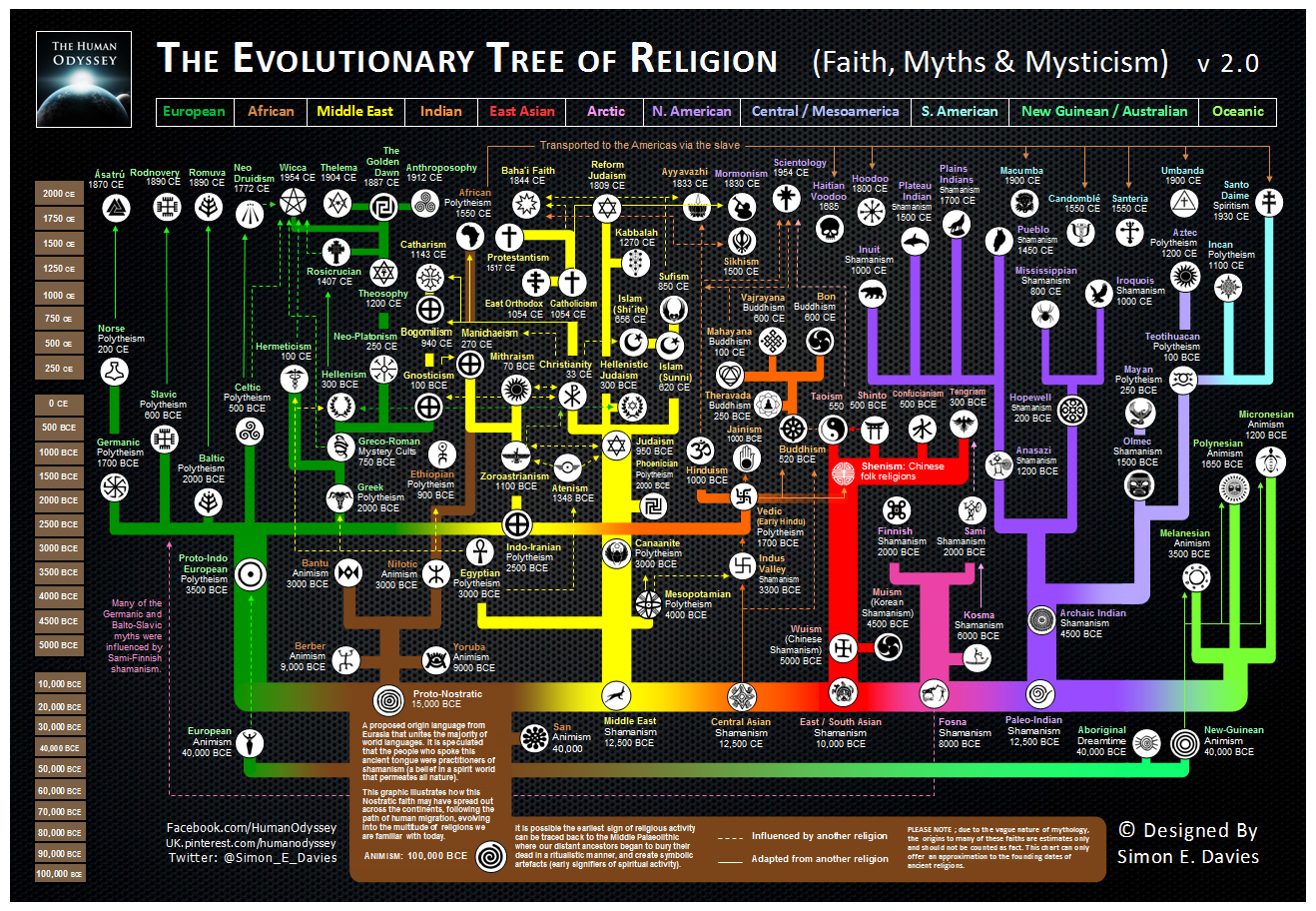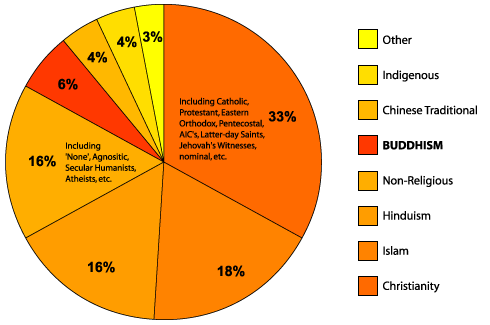Written by internationally renowned experts and lavishly illustrated with hundreds of images, this magnificent volume encompasses not just religion itself, but its entire context. Over twenty world faiths are examined here, from the eleven living religions to those of Mesopotamia, Egypt, Greece, and Rome, as well as traditional African, early Australasian, and Andean beliefs. The religious profile of the world is rapidly changing, driven primarily by differences in fertility rates and the size of youth populations among the worlds major religions, as well as by people switching faiths. Over the next four decades, Christians will remain the largest religious group, but. There are an estimated 10, 000 distinct religions worldwide, but about 84 of the world's population is affiliated with one of the five largest religion groups, namely Christianity, Islam, Hinduism, Buddhism or forms of folk religion. A History of the World's Religions bridges the interval between the founding of religions and their present state, and gives students an accurate look at the religions of the world by including descriptive and interpretive details from the original source materials. This Big Religion Chart is our attempt to summarize the major religions and belief systems of the world Buddhism, Christianity, Hinduism, Islam, Judaism, and dozens more into a quickreference comparison chart. This is a list of religions and spiritual traditions. Some entries are written more than once. A History of the World's Religions is widely regarded as the hallmark of scholarship, fairness, and accuracy in its field. Noss introduces you to the origins of world religions and shows you how they developed into the religions that impact the world we live in now. Atheists are people who believe that god or gods are manmade constructs. One of the youngest of the world's major religions. Buddhism The early history of the Center is drawn from Community and Colloquy: The Center for the Study of World Religions, , by John B. Carman and Kathryn Dodgson (Cambridge, Mass. : The Center for the Study of World Religions, 2006). These existential questions are central to the five major world religions and thats not all that connects these faiths. John Bellaimey explains the intertwined histories and cultures of Hinduism, Judaism, Buddhism, Christianity and Islam. textformat02 This book is the most thorough, yet concise history of world religions available in a single volume, discussing many subjects largely neglected in other book. A fourpart organization covers: Some Primal and Bygone Religions, The Religions of South Asia, The Religions of E. Check out this excellent diagram that maps how world religions have changed and developed, from the beginning of history to now! Davies at the Human Odyssey Facebook group, which posts content on mythology, created this incredible image of the Evolutionary Tree of Myth and Religion. The history of Hinduism is unique among the world religions in that it has no founder or date of origin. While most major religions derive from new ideas taught by a charismatic leader, Hinduism is simply the religion of the people of India, which has gradually developed over four thousand years. A History of the World's Religions bridges the interval between the founding of religions and their present state, and gives students an accurate look at the religions of the world by including descriptive and interpretive details from the original source materials. Abraham in Hindi, Duration: 4: 35. This section attempts to introduce young people to the wonder and diversity of the world's religions and spiritual traditions. We have tried to present simple, straight forward, accurate information about the world's five major religions. Online shopping from a great selection at Books Store. History of Religion: An Overview of the most Important People and Events in: The Worlds Religions, Mythologies, History of. As a percentage of the World Total, the Christian Population increased from 22. 4, with a projected figure of 33. Key Facts For the period, Christianity grew fastest in Africa, with a rate of 2. These two religions together cover the religious affiliation of more than half of the world's population. If all nonreligious people formed a single religion, it would be the world's third largest. History of Religion How has the geography of religion evolved over the centuries, and where has it sparked wars? Our map gives us a brief history of the world's most wellknown religions: Christianity, Islam, Hinduism, Buddhism, and Judaism. The World Religions chapter of this History Alive! World Connections Companion Course helps students learn the essential lessons associated with world religions. History of Religions strives to publish scholarship that reflects engagement with particular traditions, places, and times and yet also speaks to broader methodological. Indus Valley Civilization 2800 B. Eventually, the rulers took advantage of their power and the article Mastering the TEKS in World History' Chinese philosopher Confucius began to put order in China's political and social life as a response to the turmoil. Course Summary It's easy to study the history of major world religions with this engaging study guide. Our lessons are short and interesting, while the multiplechoice quizzes help you test your. Hinduism, Buddhism, Christianity, Judaism, and Islam are five of the biggest religions in the world. Over the last few thousand years, these religious groups have shaped the course of history and. There are twelve classical world religionsthose religions most often included in history of world religion surveys and studied in world religions classes: Baha'i, Buddhism, Christianity, Confucianism, Hinduism, Islam, Jainism, Judaism, Shinto, Sikhism, Taoism, and Zoroastrianism. Here are overviews of nine of these classical religions. Guide to Islam, including history, beliefs, holy days around the world and message boards. Religion remains one of the most important facets of the world we live in today. The SOLs suggest that the course begin with an overview of the five major religions of the world. To understand the world around you, you must first understand the world's top five belief systems. A History of the World's Religions bridges the interval between the founding of religions and their present state, and gives students an accurate look at the religions of the world by including descriptive and interpretive details from original source materials. A History of the World's Religions bridges the interval between the founding of religions and their present state, and gives students an accurate look at the religions of the world by including descriptive and interpretive details from original source materials. Includes the most prominent world Judaism, Islam, and Asian Religions. Religious and Sacred Texts Collection of religious and sacred texts. History of Religions sets standard for the comparative study of religious phenomena from prehistory to modern times. Learn religions world history 2 with free interactive flashcards. Choose from 500 different sets of religions world history 2 flashcards on Quizlet. In History of Religions, the progress conference is held with a panel of the area's faculty, and will normally include assessment of coursework to date, cogency of the course of study petition, readiness for qualifying examinations, and development of the dissertation project. A History of the World's Religions bridges the interval between the founding of religions and their present state, and gives students an accurate look at the religions of the world by including descriptive and interpretive details from the original source materials. Religions of the world Lewis M. 2 Native American Religions 29 The Spirit World 30 Animism 31 Contacts with the Spirit World 33 Sacrifice, 34 Taboos, 34 Ceremonies and Rituals, 35 The History of Shinto 199 Shinto Prior to 300 C. The religions of the ancient world provided answers to people's questions about life and death and, in this regard, are no different than those faiths practiced in the world today. Editorial Review This Article has been reviewed for accuracy, reliability and adherence to academic standards prior to publication. This History of World Religions Lesson Plan is suitable for 1st Grade. First graders listen to a variety of Noah's Ark, based on the story in the Old Testament. They hear another flood story for comparison. a field guide to major world religions. for the earth will be filled with the knowledge of the glory of the lord as the waters cover the sea. a field guide to major world religions. Studying the history of religion is a gateway to more than just an understanding of religious institutions. It also offers a glimpse at the propagation and function of ancient civilizations. Since the beginning of time, religion has been a significant influence on our cultures, going so far as to. History Timeline of World Religions, cults and occcult and its Founders. The true religion (way to God was given to Adam and Eve after they fell into sin). It was passed onto to his sons Ge, 4. It was then passed on until mankind rebelled and no longer practiced it. world religion section to review. Religion of the ancient Israelites. Jerusalem is center of the religion. After Judaism and Christianity. There are two world religions which have formed the cultural and ethical basis of the world as we know it. Both have an unbroken history going back thousands of years. Judaism with a 5000 year old tradition is the mother of the western civilisation through its offshoot Christianity. Religions of the World Religions of the world must be studied subjectively, or with the attitude of pluralism, the view that they are all equal. A number of methods are used to study religions. The most common is the historical comparative method in which a. History of the World's Religions Edition 13 This book is the most thorough, yet concise history of world religions available in a single volume, discussing many subjects largely neglected in other book. Belief that a series of prophets have come from God, and that Bah' is the latest religion founded by God. A liberal offshoot of Islam, but persecuted in Iran The Spread of Religions How do religions interact, adopt new ideas, and adapt to diverse cultures? As the missionaries, pilgrims, and converts of Buddhism, Christianity, and Islam moved around the world, the religions created change and were themselves changed..











